OSPF Questions 7
Here you will find answers to OSPF Questions – Part 7
Question 1
Refer to the exhibit. ROUTE.com is planning to implement a new secure OSPF network to support traffic between clients on the 172.16.10.0/24 network and the file server on the 172.16.20.0/24 network. You have been asked to review the implementation plan for the OSPF project.
Which statement about the plan is true?

A. It is complete as written.
B. It should include a task that shuts down all unused interfaces.
C. It should include tasks that enable and verify OSPF authentication.
D. It should include a task that establishes a file transfer baseline before and after the configuration is changed.
Answer: C
Explanation
The complete implementation plan should be
1. Enable OSPF process 1 on all routers
2. Enable area 0 on R2, R3 and R4
3. Enable area 10 on R1, R2 and R3
4. Enable area 20 on R4 and R5
5. Enable and verify OSPF authentication
6. Verify that all routers contain a complete routing table
7. Verify that the clients can successfully access the server
8. Document configuration changes
Question 2
Refer to the exhibit. ROUTE.com is planning to implement a secure OSPF network to support traffic between clients on the 172.16.10.0/24 network and the file server on the 172.16.20.0/24 network. You have been asked to review the implementation and verification plans.
Which statement about the plan is true?

A. It is complete as written.
B. It should include a task that verifies that the interarea routes are using the proper MED.
C. The plan should include a task that verifies that load sharing is active on the appropriate links.
D. The plan should include a task that verifies end-to-end connectivity between the clients and the file server.
Answer: D
Question 3
Refer to the exhibit. ROUTE.com is planning to implement a secure OSPF network to support traffic between clients on the 172.16.10.0/24 network and the file server on the 172.16.20.0/24 network. You have been asked to review the implementation and verification plans for this OSPF project.
Which statement about the plan is true?

A. It is complete as written.
B. It should include a task that verifies that the interarea routes are using the proper MED.
C. it should include a task that verifies that load sharing is active on R1 and R4.
D. It should include a task that verifies that all redundant links will become active when the primary links are shut down.
Answer: D
Question 4
Refer to the exhibit. Which two Cisco IOS commands on R2 would verify its OSPF neighbor relationships? (Choose two)
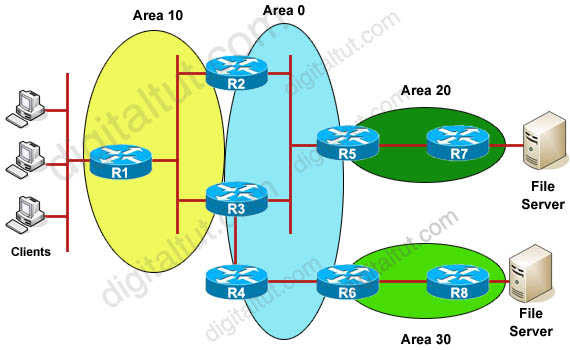
A. show ip ospf
B. show ip ospf interface
C. show ip ospf neighbor
D. show ip ospf database
E. show ip ospf statistics
F. show running-config | begin router ospf
Answer: B C
Explanation
The show ip ospf interface command shows us information about the neighbor count and adjacent neighbor count:
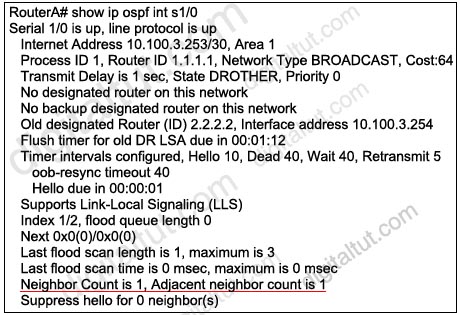
The show ip ospf neighbor command shows us the role of each neighbor (DR, BDR, DROTHER).
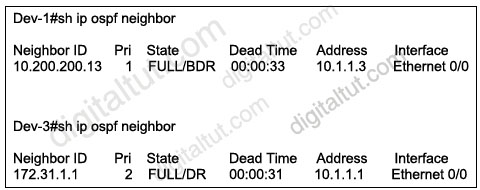
Question 5
Which command displays the number of times that the OSPF Shortest Path First (SPF) algorithm has been executed?
A. show ip protocol
B. show ip ospf interface
C. show ip ospf
D. show ip ospf database
Answer: C
Explanation
Below is the output of this command:
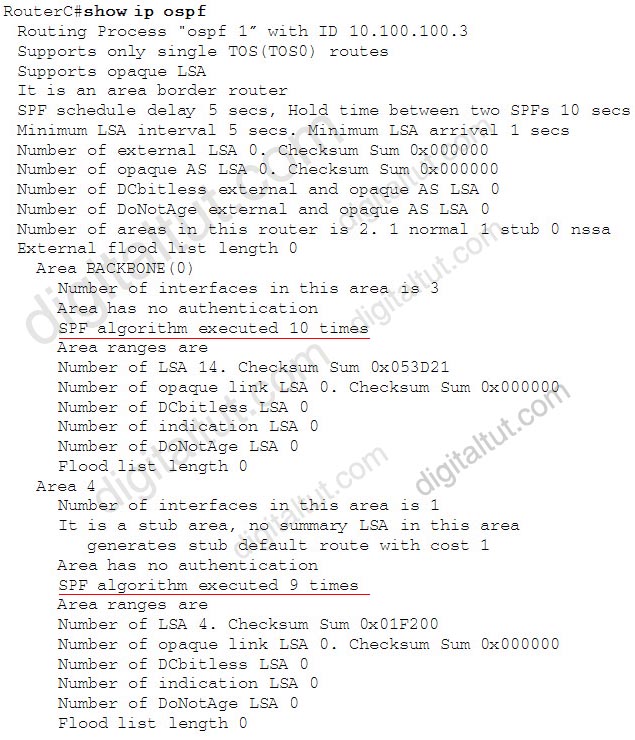
Question 6
Refer to the exhibit. Will redistributed RIP routes from OSPF Area 2 be allowed in Area 1?
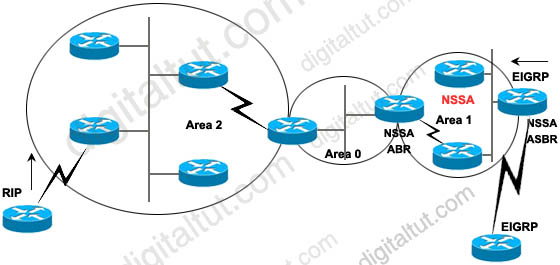
A. Because Area 1 is an NSSA, redistributed RIP routes will not be allowed.
B. Redistributed RIP routes will be allowed in Area 1 because they will be changed into type 5 LSAs in Area 0 and passed on into Area 1.
C. Because NSSA will discard type 7 LSAs, redistributed RIP routes will not be allowed in Area 1.
D. Redistributed RIP routes will be allowed in Area 1 because they will be changed into type 7 LSAs in Area 0 and passed on into Area 1.
E. RIP routes will be allowed in Area 1 only if they are first redistributed into EIGRP.
Answer: A
Explanation
Area 1 is a NSSA so we can inject EIGRP routes into this area with Type 7 LSAs. Notice that Type 7 LSAs can only be existed in a NSSA. The NSSA ABR of area 1 must converted it into LSA Type 5 before flooding to the whole OSPF domain.
When redistribute RIP into area 2, LSA Type 5 will be created an sent through area 0. But a NSSA is an extension of a stub area. The stub area characteristics still exist, which includes no type 5 LSAs allowed.
Note: A stub area only allows LSA Type 1, 2 and 3.
(Reference & good resource: http://www.cisco.com/en/US/tech/tk365/technologies_tech_note09186a0080094a88.shtml)
Question 7
Refer to the exhibit. OSPF has been configured on all routers in the network and Area 1 has been configured as a NSSA. Which statement is true about the NSSA Area 1?
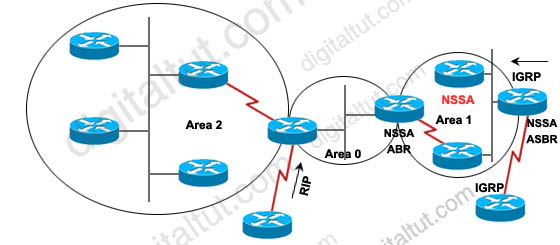
A. Redistributed RIP and IGRP routes will appear in Area 1. They will be advertised via type 5 LSAs.
B. Only redistributed RIP routes will appear in Area 1. They will be advertised via type 7 LSAs.
C. Only redistributed IGRP routes will appear in Area 1. They will be advertised via type 7 LSAs.
D. No redistributed routes can appear in Area 1, only summary routes.
Answer: C
Explanation
Same explanation of Question 6. Please notice that the IGRP routes are redistributed to NSSA area 1 via LSA Type 7. The NSSA ABR of area 1 will convert it into a LSA Type 5 before flooding to area 0 & area 2.
Question 8
Refer to the exhibit. Based on the command output, what is one reason why no routes from the OSPF neighbor 192.168.0.5 are installed in the IP routing table?
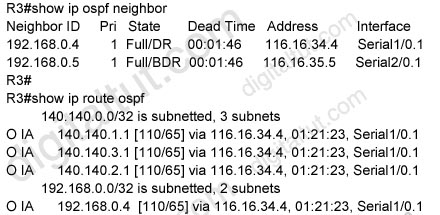
A. R3 will only install routes from the neighbor with the lowest priority (Pri). If routes have the same priority, routes from the neighbor with the lowest IP address are used.
B. R3 did not receive any LSAs from 192.168.0.5.
C. Routes from backup designated routers are never installed in the IP routing table.
D. 192.168.0.5 is a redundant link to 192.168.0.4, and load balancing is not enabled.
Answer: B
Explanation
R3 may not receive any LSAs from neighbor 192.168.0.5 because a distribute-list blocks it. But notice that the LSAs are not filtered out in the LSDB since all routers in an OSPF area must be the same (synchronized).
Question 9
Refer to the exhibit. OSPF is running throughout the network. You want to minimize the propagation of LSAs into and out of Area 1.
Which OSPF feature would best achieve this goal?
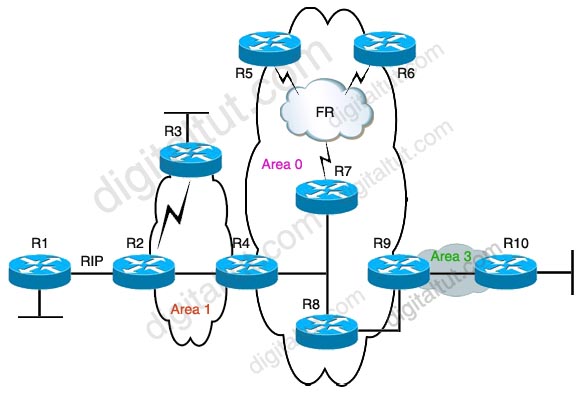
A. stub
B. totally stubby
C. NSSA
D. totally NSSA
Answer: D
Explanation
We need to redistribute RIP from R1 to Area 1 so Area 1 cannot be a stub or totally stubby area. To minimize the propagation of LSAs into and out of Area 1 we should configure it as a totally NSSA. Notice that a NSSA allows LSA Type 3 & 7 while a Totally NSSA only allows LSA Type 7.
Note:
Both Totally Stubby Area & Totally Stubby NSSA do not accept external AS routes or inter-area routes (LSA Types 3, 4 and 5). They recognize only intra-area routes and the default route 0.0.0.0. The main difference between them is Totally Stubby NSSA accepts routes from other AS while Totally Stubby Area does not.
Below summarizes the LSA Types allowed and not allowed in area types:
| Area Type | Type 1 & 2 (within area) | Type 3 (from other areas) | Type 4 | Type 5 | Type 7 |
| Standard & backbone | Yes | Yes | Yes | Yes | No |
| Stub | Yes | Yes | No | No | No |
| Totally stubby | Yes | No | No | No | No |
| NSSA | Yes | Yes | No | No | Yes |
| Totally (stubby) NSSA | Yes | No | No | No | Yes |
Question 10
Refer to the exhibit. A company would prefer all Internet-bound OSPF routed traffic to use ISP ABC with ISP DEF as a backup. As the network consultant, what three configuration changes might you make? (Choose three)
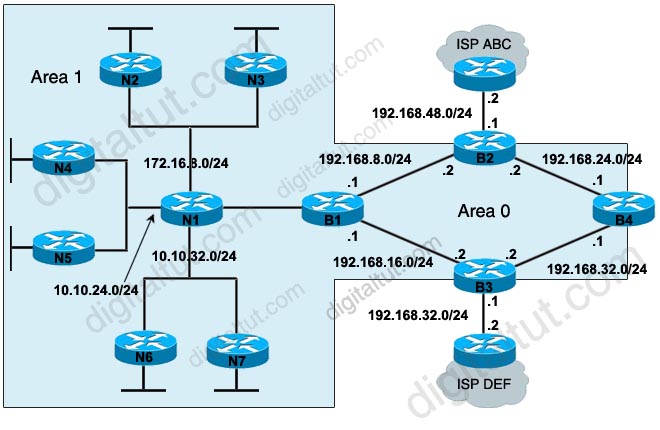
A. The default-information originate command should be configured on router B1 and B4.
B. The default-information originate command should be configured on router B2 and B3.
C. If the metric value for ISP ABC is set at the default, the ISP DEF metric value should be set to 1.
D. If the metric value for ISP ABC is set at the default, the ISP DEF metric value should be set to 25.
E. The metric type value should be set to type 1.
F. The metric type value should be set to type 2.
Answer: B D F
Explanation
Routers B2 & B3 need to advertise a default route to the Internet for “inside” OSPF routers so we should use the “default-information originate” command with a default route (something like “ip route 0.0.0.0 0.0.0.0”) pointing to the ISP router -> B is correct.
If no metric is specified, OSPF puts a default value of 20 when redistributing routes from all protocols except BGP routes (BGP routes get a metric of 1). We use ISP DEF as a backup so its metric value should be set to a higher value than 20 -> D is correct.
There are two types of external routes: external type 1 and external type 2. The difference between the two is in the way the cost (metric) of the route is being calculated:
+ The cost of a type 2 route is always the external cost, irrespective of the interior cost to reach that route.
+ Type 1 cost is the addition of the external cost and the internal cost used to reach that route.
-> We should configure the type 2 external route to make sure the ISP ABC is always referred over ISP DEF because internal routing does not determine the path.
Note: E2 is the default external metric, but E1 is preferred over E2 if two equal-cost paths exist.
Question 11
Refer to the exhibit. A network administrator wants to reduce the number of OSPF routes advertised from Area 1 into Area 2. As the router configuration specialist, what two things would you do to accomplish this goal? (Choose two)
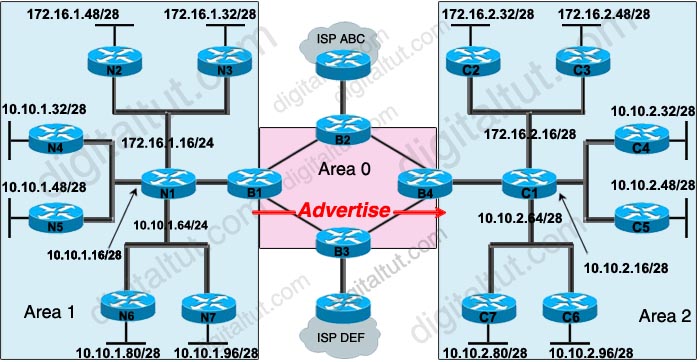
A. Enter the configuration on router B1.
B. Enter the configuration on router B4.
C. On the same router, enter the Summary-address 10.10.1.0 255.255.255.128 subcommand.
D. On the same router, enter the Area 1 range 10.10.1.0 255.255.255.128 subcommand.
E. On the same router, enter the Area 2 range 10.10.1.0 255.255.255.128 subcommand.
Answer: A D



Could some one explain the Q.11 please?
just don’t get how 10.10.1.0 255.255.255.128 come from and what happen to 172.16 network.
liktof, all D supposed to be doing is putting all the IPs from 10.10.1.0 – 10.10.1.127 IPs into a single advertisement, instead of doing individual advertisements.
ie
network 10.10.1.80 0.0.0.0 area 1
network 10.10.1.64 0.0.0.0 area 1
network 10.10.1.32 0.0.0.0 area 1
network 10.10.1.48 0.0.0.0 area 1
network 10.10.1.16 0.0.0.0 area 1
now it can be done like this:
network 10.10.1.96 0.0.0.128 area 1
that way when router B4 gets it, it doesn’t get individual routes but instead a summarized version.
also the 10.x.x.x has 5 networks per side whereas the 172.x.x.x only has 3. so in reality, the question could have also asked about the 172.x.x.x network but they did not, only focusing on the 10.x.x.x
Excellent, what a webpage it is! This weblog gives vaqluable information to us,
keep it up. http://www.albung.no/odt/index.php?p=news&id=60